Life during COVID-19: Help and support
Families in Australia Survey report
August 2020
Mikayla Budinski, Jennifer Baxter, Megan Carroll, Kelly Hand
Download Research report
Overview
This report is drawn from the Life during COVID-19 survey, which ran during the first wave of the pandemic in Australia.
During the pandemic, many people needed more help than they did before. In this report, we look at how we helped, and were helped by, our relatives, friends and neighbours, and by community groups and professionals. We explore who got the help they needed, and who didn't.
Key messages
-
During lockdown, relatives were our leading source (from people outside of our household) of financial support and help with things such as shopping and domestic work.
-
Friends were a leading source of emotional support, and community organisations were key providers of personal care and mobility.
-
People living in cities were more likely to receive emotional support than people living in regional and remote areas. But people living in remote areas were more likely to receive physical help than people in cities and regional centres.
-
People aged 50-69 years were the most likely to give help and the least likely to receive it.
-
People in remote areas and people aged 18-29 were less able to access professional help than other groups, despite needing it more.
I volunteer at a local Salvation Army Corps and a Legacy Club. I am a people person, I care for others but have not been allowed to do so in person… Social isolation has stopped many of the vulnerable from reaching out and has prevented those who care from knowing their needs.
Male, 70, lives in a regional area, household with children
How COVID-19 changed the way we help
More than one in three people (37%) said that prior to the COVID-19 pandemic they regularly helped people outside their household. When the pandemic struck, nearly one in five helpers (19%) said they had to stop giving help, and half (50%) had to change the way they provided help.
The pandemic impacted people's ability to help, and caused many people who needed help to struggle to get it.
Being a friend means being there to help, hug, in times of need. This has not been possible during the isolation.
Female, 58, lives in a major city, single-adult household
My level of contact has changed in terms of more 'support' for others, especially elderly parents. Before COVID it was much more about social catch up and fun...now it's about making sure they're safe, have what they need, aren't too worried, correcting false assumptions found on social media etc.
Female, 59, lives in a major city, household with children
Who did the helping and how did they help?
Three in four people (74%) said they had provided some kind of help to someone outside their household in the past month, including emotional and financial support.
| Type of help | % |
|---|---|
| Emotional support | 55 |
| Shopping or provision of food or supplies | 36 |
| Transport or errands | 20 |
| Financial support | 15 |
| Performing domestic work, home maintenance or gardening | 11 |
| Personal care or mobility support | 6 |
| Other | 13 |
| None | 26 |
Note: n = 6,729
Of the specific types of help listed, the most commonly provided was emotional support. But also 58% of respondents said they had given some type of physical help, i.e. shopping, provision of food, domestic work or help with transport, personal care or mobility support.
People aged under 30 and over 70 were less likely than other people to be regularly helping someone outside their household, while four in five people aged between 50-69 reported providing physical, emotional or financial support to someone outside their household.
Women were more likely than men to help someone outside their household (76% vs 67%), commonly with food or supplies (39% vs 28%) and providing emotional support (59% vs 42%). While women were more likely than men to provide at least one form of physical help (45% vs 39%), men were slightly more likely to help specifically with jobs around the home (14% vs 10%). Men were also more likely to provide financial support (19% vs 15%).
Our in-person contact has not been physical and we have maintained the social distancing regulations. We have been shopping for my husband's parents who are over the age of 70 and doing errands for them so they can stay home safe.
Female, 43, lives in a major city, multiple-adult household, no children
My son is a chef and was one of the first industries to be affected. I have had to help him financially as it took weeks for any jobseeker payments to flow through…
Female, 59, lives in a major city, single-adult household
Figure 1: Type of help given to someone outside of household, by age
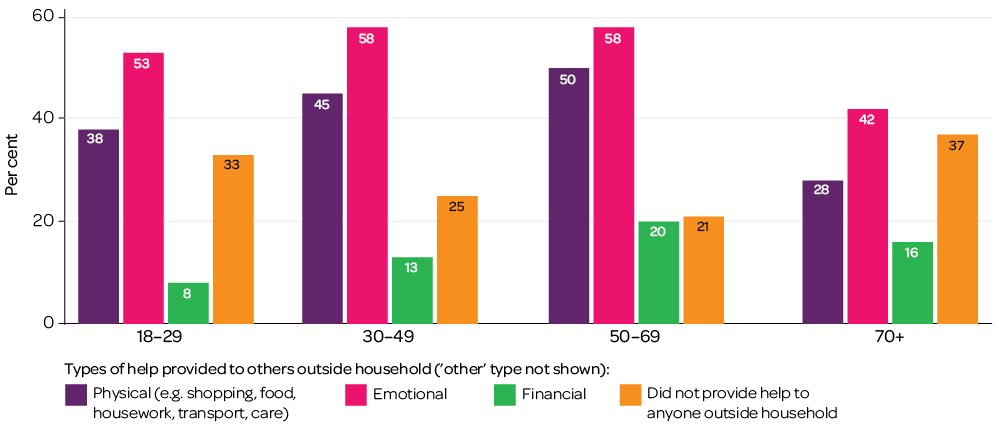
Figure 2: Who did you give help to, by age of respondent
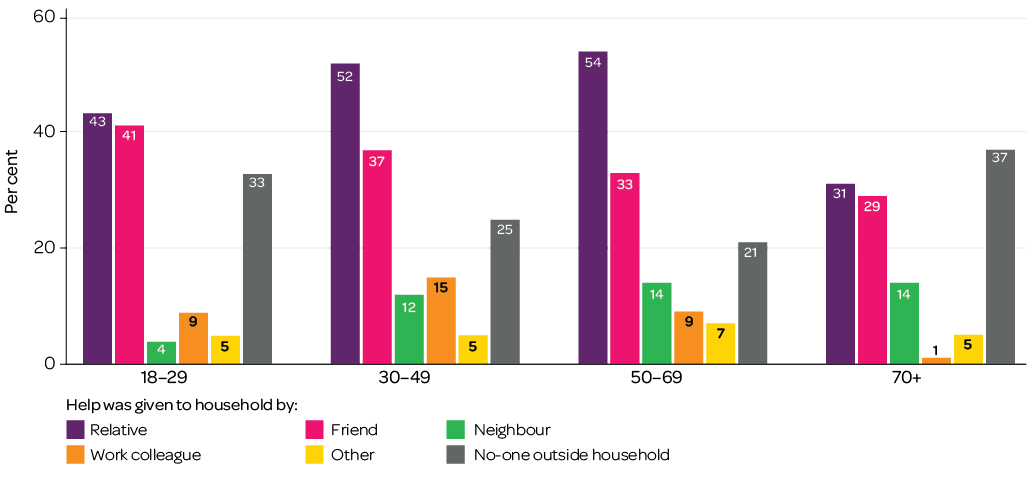
Younger people were more likely than other people to help friends outside their household. People aged from 30 to 69 were more likely than younger and older people to help relatives.
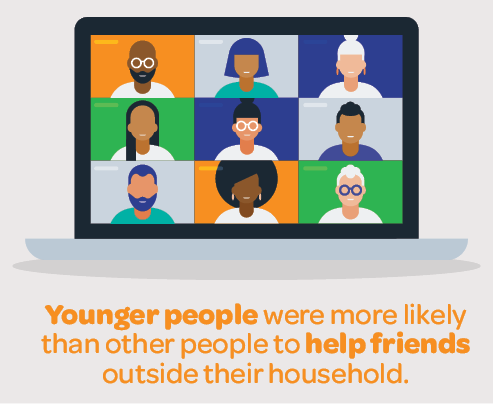
Caring for elderly parents living elsewhere. Doing their shopping, getting their medication supplies, advocating during tele health calls, house cleaning and general care as required.
Female, 61, lives in a major city, couple-only household
New dimension of extended family caring emerged in relation to a family member in financial crisis due to job loss… Family member had to reach out for help with food and rent. Group messaging via Facebook, used with family to coordinate help to the family member in crisis…
Female, 45, lives in a regional area, couple-only household
Many of our neighbours are elderly, over 70 years of age, so we have been doing some shopping, running errands on their behalf and calling them more than usual over the phone to make sure they are OK…
Female, 55, lives in a major city, multiple-adult household, no children
Who did we get help from, and what help did we get?
On the other side of the coin, receiving help, just under one in two people (46%) reported that they or someone they lived with had received help from someone outside their household. Overall, one in four (24%) reported getting at least one type of physical help, the most common type being help with shopping or provision of food or supplies (19%). Further, 27% received emotional support, 4% received financial help and 4% some other help, with just over half (54%) saying they did not get any help.

In terms of age:
- People aged under 50 were more likely to receive emotional and financial support than older people.
- People aged 70 and over were more likely than others to receive physical help.
- People aged 50-69 years were the least likely to receive help.
My neighbours and various family members have shopped for me. From my apartment I can see people passing all the time, so I do not feel isolated at all.
Female, 75, lives in a major city, single-adult household
In terms of where people lived, that is in a major city, regional area or remote area: people living in major cities were more likely (30%) than those in regional (26%) or remote areas (22%) to receive emotional support; people in remote (29%) and regional areas (28%) were more likely to receive physical support than those in major cities (22%).
Figure 3: Type of help received from someone outside of household, by age of respondent
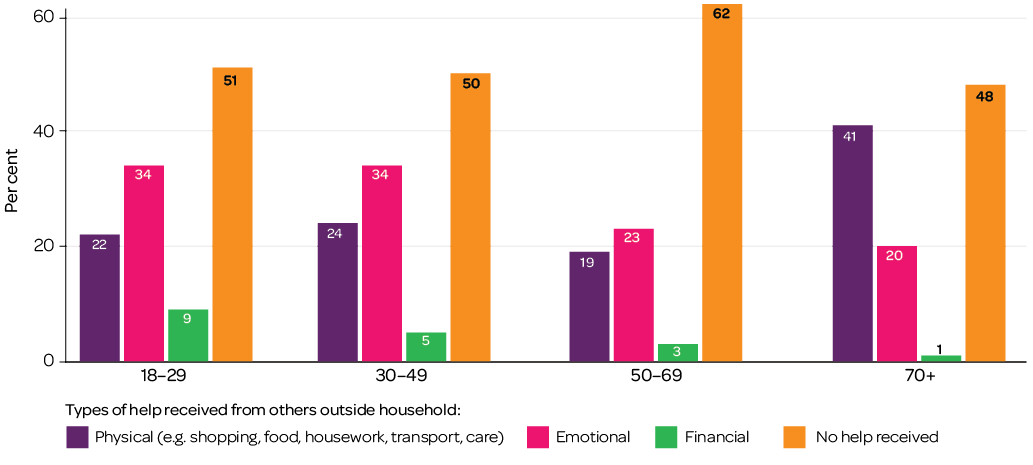
Relatives were the most common source of help, with more than one in four people saying their household got help from a relative living elsewhere.
Just over half of the people who received help (56%) received it from only one source of help (e.g. relatives or friends). However 44% received help from two or more sources.
Figure 4: Who did the household receive help from?
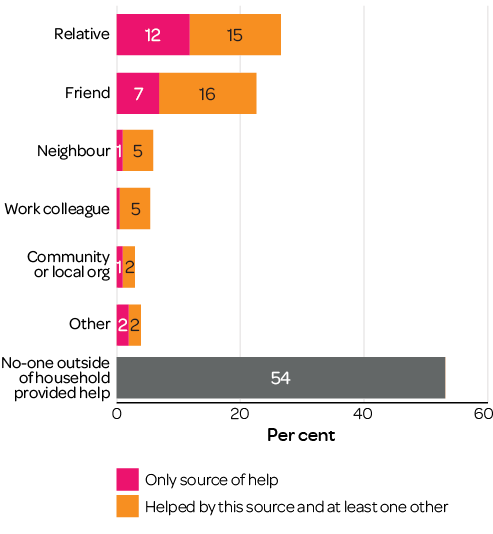
While relatives were the leading providers of all kinds of help, there was some variation in type of help by source:
- Emotional support mostly came from friends, relatives and work colleagues.
- People receiving help from neighbours were mostly getting help with shopping or the provision of food and supplies.
- People receiving help from community organisations or other sources were mostly receiving help with domestic work, home maintenance and gardening.
I have found that people are genuinely concerned about how I am and how I feel. Example: strangers will stop me and ask if I'm okay, people help me when I struggle with my shopping. Daughter helps me with my weekly shopping, neighbours ring up or come and see if I am okay. I have been given meals or treats by neighbours many whom I have never met in person before. I do not use iPad so a friend helped me fill out this survey.
Male, 83, lives in a regional area, single-adult household
One of my neighbours sent a letter at the beginning of the social distancing with offer of shopping, walking dog or anything else I might need.
Female, 60, lives in a major city, household with children
Have 90+ year old mother who lives independently alone… She receives weekly news items from her local church community via email. Her local doctor has contacted her by phone to say 'hello'. Her local city council offers shopping and cleaning support. She's an example of someone with strong links to the community and she is pro-actively managing to maintain those links… In an amazing 'role reversal' of sorts, she has enabled many younger members of a four generation extended family to remain in good spirits. An inspiration, really.
Female, 67, lives in a major city, couple-only household
Professional help
Almost everyone, at one time or another, will find themselves in need of professional help, whether it's from a GP, counsellor or psychologist. However, not everyone can get the help they need when they need it. The restrictions during COVID-19 made access to professional services generally more challenging.
Access to professional help
The most-needed service during the first wave of the pandemic was GP and primary health care, with just over half (53%) of people saying they needed to access a GP or health care professional. Only 11% of those needing a GP or primary care service were unable to access it.
Fewer respondents reported needing mental health services, counselling or family relationship services, but the unmet demand was greater for these services among those who needed them.
Other services needed that were unable to be accessed included dentists, physiotherapists, optometrists, specialists, surgeries and massage therapies.
Figure 5: Services needed and accessed

Note: 'Other services' denotes dentists, specialists etc.
Telehealth has been a godsend, but I am concerned that I will need to travel soon because my counsellor went on maternity leave and the new counsellor wants face-to-face (understandable). I am immuno compromised due to medications.
Female, 54, lives in a major city, household with children
Differences in access to professional help
A key factor associated with whether people accessed a service they needed was where they lived (i.e. in a city, regional centre or remote area). People living in regional and, in particular, remote areas were less likely than people living in cities to access services they needed.
- Mental health services: In cities, 23% of people said they needed to access the service, but 52% of those in need could not do so. In regional centres, 21% of people said they needed to access the service, but 62% of those in need could not do so. And in remote areas, 25% of people needed to access the service, but 68% of those in need said they could not do so.
- Counselling: In cities, 22% of people said they needed to access the service, but 50% of those in need could not do so. In regional centres, 20% of people said they needed to access the service, but 55% of those in need could not do so. And in remote areas, 23% of people needed to access the service, but 70% of those in need said they could not do so.
- GPs and primary care: In cities, 53% of people said they needed to access the service, but 10% of those in need could not do so. In regional centres, 54% of people said they needed to access the service, but 14% of those in need could not do so. And in remote areas, 50% of people needed to access the service, but 17% of those in need said they could not do so.
Apart from regional differences, access to services varied across age groups. Younger people were more likely than older people to say they needed access to mental health services and counselling, but also unable to access them. People under 50 were also more likely to have needed but not to have accessed family relationship services.
Figure 6: Services accessed, or needed but not accessed, by geographical location
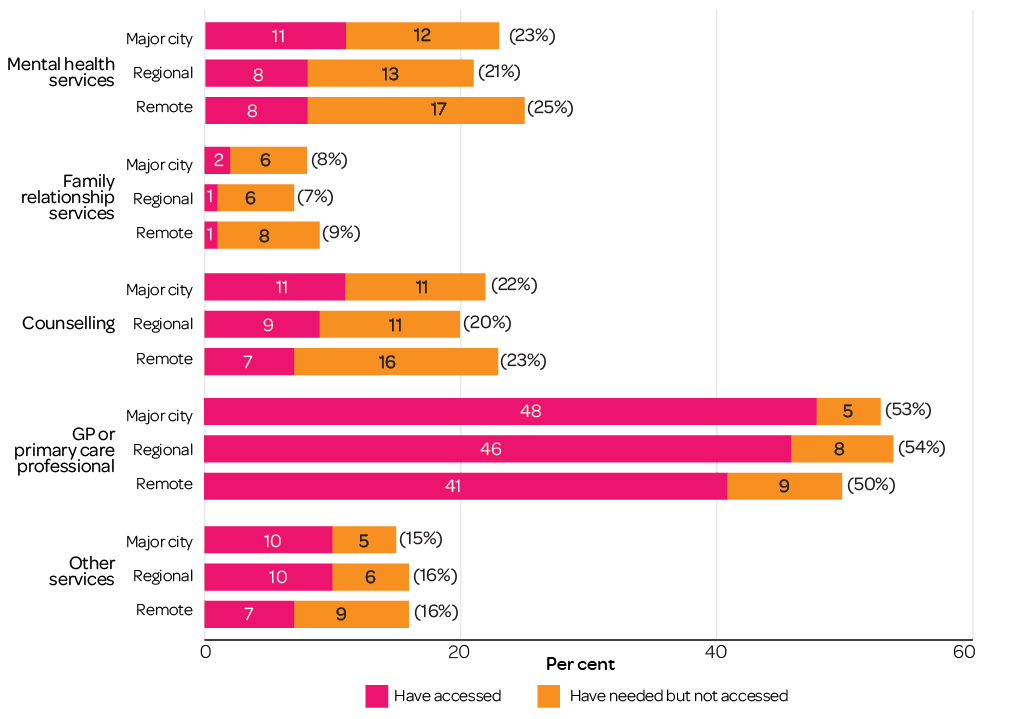
Help for people living with illness or disability
Twelve per cent of respondents reported that they, or someone they lived with, regularly required help with daily tasks due to disability or chronic illness.
Among this group, 43% reported receiving physical help and 17% receiving either financial or emotional support from someone outside their household in the past month. While relatives and friends were their primary sources of help, they were more likely than other people to also be receiving help from community or local organisations (14% vs 2% of households without a disability or chronic illness).
Comments by people living with illness or disability indicated that in the face of COVID restrictions some were struggling to have their needs met. They found that supports such as home help, respite care and therapy could not be easily substituted with telehealth.
Our two-year-old foster daughter has special needs and receives OT, speech and physiotherapy. In the past, this meant weekly visits in our home a therapist who would interact with our little girl. Now, all of her therapy as well as medical reviews are done by video and I have to do all of her therapeutic intervention myself.
Female, 59, lives in a major city, multiple-adult household with children
My disabled son has less contact with his NDIS [National Disability Insurance Scheme] supports because of social distancing.
Male, 72, lives in a regional area, couple-only household
I used to do hydrotherapy and exercise physiology through BlueCare, which has stopped but their physios have arranged a once a week an exercise session for the group using Zoom…
Female, 73, lives in a regional area, single-adult household
About the survey
Life during COVID-19 was the first survey in the Families in Australia Survey (AIFS' flagship survey series). The first wave ran from May 1 to June 9 2020, when all states were in various stages of lockdown. There were 7,306 respondents. A second survey wave is planned for November 2020.
Resources and further information
We have gathered a list of resources to support families through the coronavirus crisis. These include government resources, mental health support services, and child and family support services.
Contact
For more information, visit the Families in Australia Survey project page or email [email protected].
Editor: Michael Day
Graphic design: Lisa Carroll
Featured image: © GettyImages/Warchi
Budinski, M., Carroll, M., Baxter, J., & Hand, K. (2020). Life during COVID-19: Help and support. (Families in Australia Survey report). Melbourne: Australian Institute of Family Studies.